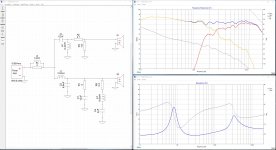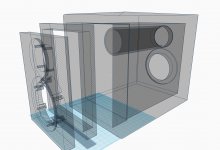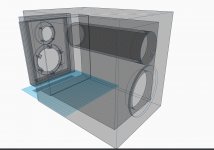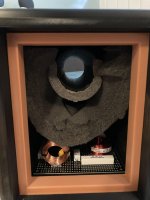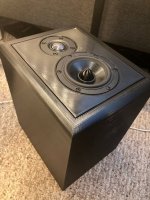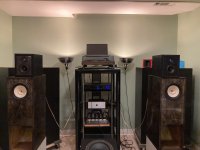So this has been a fun project that I've been scheming up for a while.
I decided about four months ago to start designing a 3D-printable loudspeaker enclosure for a small 2-way design, using a Dayton RS100P-4 4" paper cone woofer and Dayton NHP25F-4 1" neo soft dome tweeter.
The design goals were:
- Bass reflex for halfway-decent LF output (Let's be real, a 4" paper cone isn't going to do much below 60Hz without a lot group delay and silly enclosure sizes.)
- Very good vertical off-axis response
- +/-1.5dB on-axis response from 80Hz to 15kHz
- Small footprint that can fit on a consumer 3D printer (In this case, a heavily-modified TronXY X5SA-Pro)
- Sub-$500 price point for all materials required
- CC/Share-Alike/Non-Commercial enclosure files in STL format for public use, for anyone else out there that wants a fun project to work on. The crossover schematics and BOM will also be released soon. (They're by no means at the final stage at this point, but are getting close to the finish line for the first revision.)
To start off with, I picked these drivers because they have a fairly flat response, good damping and only required second-order slopes for solid integration. The tweeter faceplate is tiny, allowing the acoustic centers to be only ~8cm distance from each other, allowing for good vertical off-axis response. (See Attachment 1 for prototype baffle) They are also inexpensive, coming in at around $120 bucks for both woofers and tweeters for the pair, which was vital in hitting the price point, but not sacrificing too much.
The crossover utilizes a few standard arrangements to form the full network. The usual electrical 2nd-order slope bits (actual acoustic slopes are a bit on the gentle side), along with a notch filter (to combat a rise in the response around 3.2kHz) and zobel on the woofer. Baffle step correction on the whole enchilada to combat a rise in response centered around 1kHz. (See Attachment 2 for v1.0 [aka v3_1] crossover.) Overall response *should* be nice and tidy, and make minor adjustments where necessary.
The enclosure is fairly thick, and should weigh approxiately 4kg when assembled (~5-5.5kg with crossover, drivers, and various wiring/gasketing/terminal cup/foam). Utilizing PLA filament with 60% density cubic infill and 2.5mm-thick perimeters/tops/bottoms, the structure should be very rigid with little cabinet resonance. Approximate volume is 5.4L with a port tune of 70Hz, giving about 2.5dB gain at 74Hz, f3 at 58Hz. Maximum calculated group delay is 15ms at 65Hz, which isn't half bad. Xmax is reached with 15W input power @93Hz. (See Attachments 3 and 4 for shots of the enclosure.)
I'll be updating as more comes along. V1.0 enclosure STLs are also attached below in a zip file.
Cheers,
Kev (Alekk)
I decided about four months ago to start designing a 3D-printable loudspeaker enclosure for a small 2-way design, using a Dayton RS100P-4 4" paper cone woofer and Dayton NHP25F-4 1" neo soft dome tweeter.
The design goals were:
- Bass reflex for halfway-decent LF output (Let's be real, a 4" paper cone isn't going to do much below 60Hz without a lot group delay and silly enclosure sizes.)
- Very good vertical off-axis response
- +/-1.5dB on-axis response from 80Hz to 15kHz
- Small footprint that can fit on a consumer 3D printer (In this case, a heavily-modified TronXY X5SA-Pro)
- Sub-$500 price point for all materials required
- CC/Share-Alike/Non-Commercial enclosure files in STL format for public use, for anyone else out there that wants a fun project to work on. The crossover schematics and BOM will also be released soon. (They're by no means at the final stage at this point, but are getting close to the finish line for the first revision.)
To start off with, I picked these drivers because they have a fairly flat response, good damping and only required second-order slopes for solid integration. The tweeter faceplate is tiny, allowing the acoustic centers to be only ~8cm distance from each other, allowing for good vertical off-axis response. (See Attachment 1 for prototype baffle) They are also inexpensive, coming in at around $120 bucks for both woofers and tweeters for the pair, which was vital in hitting the price point, but not sacrificing too much.
The crossover utilizes a few standard arrangements to form the full network. The usual electrical 2nd-order slope bits (actual acoustic slopes are a bit on the gentle side), along with a notch filter (to combat a rise in the response around 3.2kHz) and zobel on the woofer. Baffle step correction on the whole enchilada to combat a rise in response centered around 1kHz. (See Attachment 2 for v1.0 [aka v3_1] crossover.) Overall response *should* be nice and tidy, and make minor adjustments where necessary.
The enclosure is fairly thick, and should weigh approxiately 4kg when assembled (~5-5.5kg with crossover, drivers, and various wiring/gasketing/terminal cup/foam). Utilizing PLA filament with 60% density cubic infill and 2.5mm-thick perimeters/tops/bottoms, the structure should be very rigid with little cabinet resonance. Approximate volume is 5.4L with a port tune of 70Hz, giving about 2.5dB gain at 74Hz, f3 at 58Hz. Maximum calculated group delay is 15ms at 65Hz, which isn't half bad. Xmax is reached with 15W input power @93Hz. (See Attachments 3 and 4 for shots of the enclosure.)
I'll be updating as more comes along. V1.0 enclosure STLs are also attached below in a zip file.
Cheers,
Kev (Alekk)
Attachments
Last edited:
V1.0 is complete! Attached a couple photos of the interior and exterior. Angled stands are going to be a must to make sure everything is time-aligned at the listening seat, but it's not so aggressive as to soften the treble significantly on-axis (It's around 9-10 degrees out or so on the measurement, which is also attached. Don't mind the suck-out at ~330Hz, was measuring angled from the floor as a quick-and-dirty to check HF and crossover. Gated at 4ms, measured from 24" distance). The PLA enclosure is extremely sturdy, and doesn't seem to have troublesome amounts of resonance.
V1.1 files are ready for release as well, which recesses the tweeter a few mm back (with a bit of a flare), pulling the crossover lobe upward and allowing for a better sum without angle. This version is a lot more stable and closer to a final design. Also added mounting holes to allow for quicker baffle revisions.
V1.1 files are ready for release as well, which recesses the tweeter a few mm back (with a bit of a flare), pulling the crossover lobe upward and allowing for a better sum without angle. This version is a lot more stable and closer to a final design. Also added mounting holes to allow for quicker baffle revisions.

